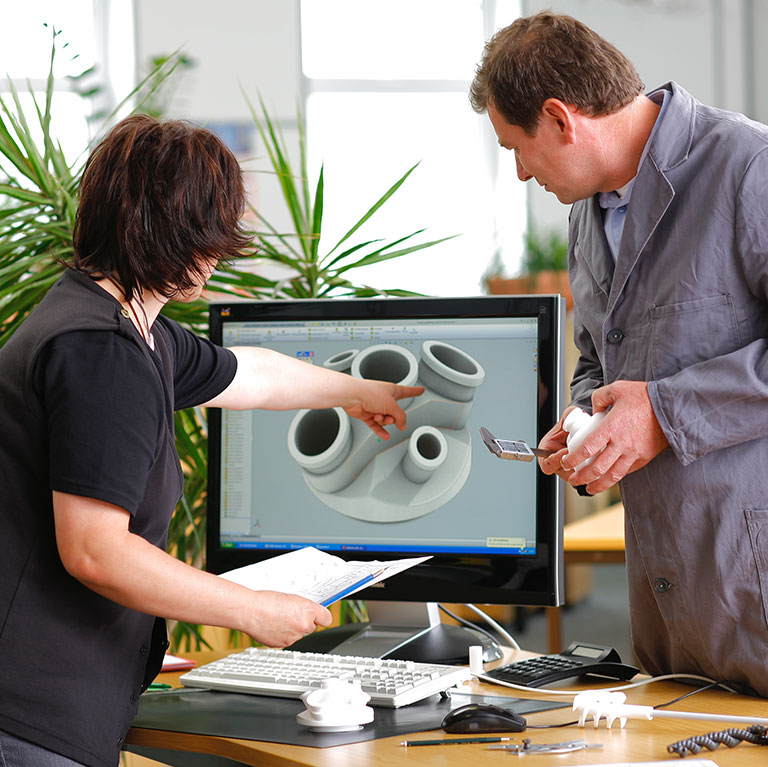Fluoroplastics - Cleaning and Worth Knowing
All fluoroplastics, PTFE, PFA and FEP have a smooth, non-wetting surface and can usually be cleaned without any problems. Abrasive scouring agents might damage the surface and result in a milkiness of the vessels – especially those made of PFA and FEP. You may use all neutral detergents (pH 7). For a stronger contamination we recommend to use an alkaline detergent up to pH 12. Clean or dry vessels in a laboratory washing machine only when they are completely opened.
Cleaning and re-utilisation of tubing
In principle, fluoroplastic tubing shall only be reused provided the material which shall be conveyed is known and rated with + in the chemical resistance chart. If the first conveyed products or components of chemical compounds are unknown, the reuse of tubing cannot be recommended. Appropriate detergents are all water-soluble substances (such as salts, acids, lyes, etc.). Volatile solvents such as alcohols, ester, ketones, low-boiling hydrocarbons, chlorinated hydrocarbon, etc. will be reversibly dispended during aerated storage provided the substance was not absorbed by the inner layer of the tubing. After use with toxic or hazardous materials as well as with substances which only can be removed by using organic solvents, the tubing should be professionally disposed. Prior to reuse, cleaned tubing has to go through a visual inspection, respectively in case of doubt an inspection as per EN 12115 has to be made.
Autoclaving at +121 °C and 134 °C
Vessels made of PTFE, PFA or FEP can be sterilised using steam at +121 °C / 30 minutes respectively at 134 °C / 10 minutes. Besides a steam pressure sterilisation, a dry sterilisation at +160 °C is also possible. In order to avoid any plastic deformation, vessels with screw covers or stoppers have to be open while being autoclaved respectively sterilised. Autoclaving/Sterilisation of closed vessels can destroy them. Sterilisation of vessels made of fluoropolymers with high-energy radiation, gamma radiation or electron radiation is not recommended since this can cause a degeneration of the mechanical properties of the fluoropolymers.
Cleaning for trace analysis
To prevent contamination with cations or anions in trace analysis, the vessels should first be filled with an 1N HCL and HN03 solution. This solution should be left inside the vessels for maximum 6 hours at room temperature before rinsing the vessels with clean distilled water. Following test methods, which are common in the semiconductor industry, the vessel surfaces can also be cleansed by storing them for 24 hours in deionised water at +85 °C. In this case the vessels should be rinsed with deionised water as well.
Pressure resistance of bottles
Due to their thin walls, standard PTFE, PFA or FEP bottles should not be pressurised (from inside). Pressurisation could result in permanent deformation.
Plastics in microwave ovens
Plastics in general and fluoroplastics with their high thermal resistance in particular are suitable for microwave energy. The microwaves solely heat the contents of the vessel. Fluoroplastic vessels are particularly suitable for heating of aggressive chemicals such as acids or solvents. However, it should be noted that produced vapours are sufficiently drawn off. The more, a controlled drainage to a collecting vessel has to be arranged in case of bursture of the rupture membrane in the digestion vessel. Other vessels or containers than digestion vessels may only be heated when open.
Response times of temperature probes
The response time of a temperature probe is determined by introducing the probe to a step change in temperature and measuring how long the probe takes to reach a certain proportion of its final, steady-state reading. Normally, T50 (the time taken to reach 50% of the final reading) or T90 (the time taken to reach 90% of the final reading) are stated.
Field-proven method of determination: Put the temperature probe in an ice cold water bath and let it reach a steady-state. Then transfer it quickly to a column of steam and monitor its resistance until a steady state is reached again.
Fluoroplastics - Heating
It is difficult to heat PTFE due to its bad heat transmission and since the max. surface temperature may not be exceeded. There are different methods to heat PTFE vessels:
Heating by a heating mantle with surface sensor:
When heating with a heating mantle, a large surface of the vessel is covered. This supports the heat transmission and reduces the heating period. The mantle must have a sensor on its surface. This probe measures the temperature on the surface of the PTFE and switches the mantle of upon exceeding +260 °C. Only this way temporary overheating and harmful decomposition products are avoided.
We advise against the use of “usual” heating mantles and control systems. Their use may result in the same effects as the use of hotplates.
Heating by a thermostat:
The heat transmission is provided by the bath medium (oils or other liquids). Controlled by an adjusted thermostat the temperatures on the surface of the PTFE vessel will not become too high. Depending on the immersion depth, a big surface for a good heat transmission is provided. The only disadvantage is the danger which occurs when working with oils at high temperatures.
Not appropriate methods are:
Flame (e.g. gas burner): With this method, the surface temperature cannot be controlled. Due to temporary overheating harmful decomposition products can occur.
Hotplate: Overheating can occur as well. Usual hotplates can only be switched on or off. During the heating period, the plate is heated with full energy so that it almost glows. Afterwards, the hotplate is switched off and only heats for a few seconds. This so-called „pointing“ is enough to exceed the maximum temperature of +260 °C. It does not make sense to put the adjusting knob only to +150 °C. PTFE labware char on the underside and glue to the hotplate. The thermoplastics PFA and FEP melt directly, similar to a hot-melt-type adhesive. This can be prevented by putting an aluminium foil between hotplate and vessels but dangers for health cannot be avoided.































































